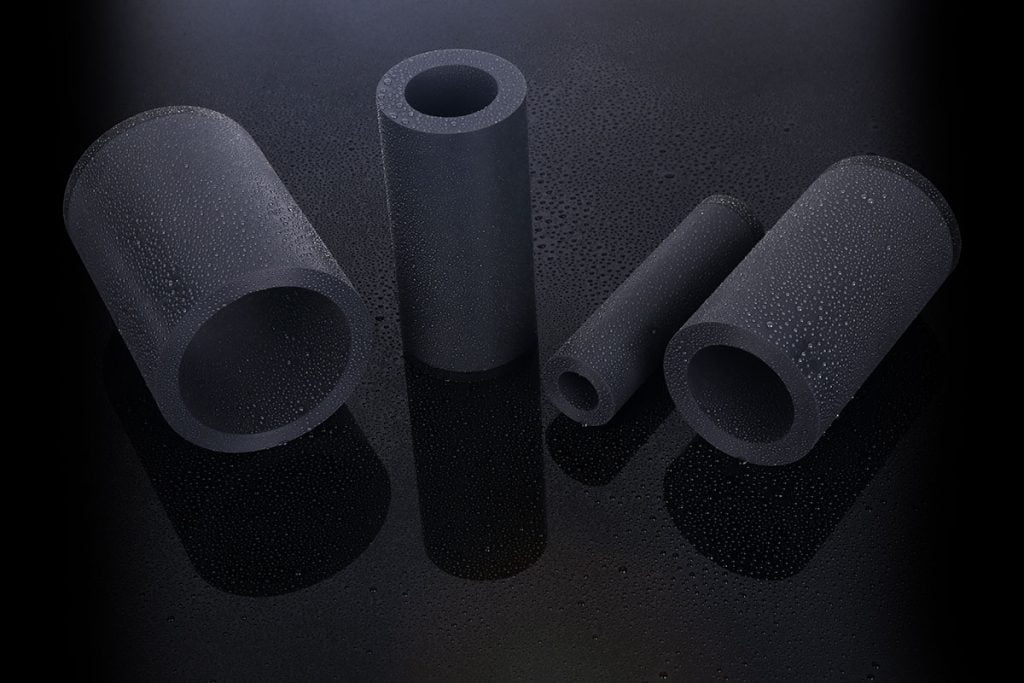
MAX XSH-PUR is an extra hard, self-smoothing polyurethane
Seal quality varies significantly, primarily driven by their material composition, which determines longevity and overall performance. Through the phases of design, development, production, and distribution, each seal undergoes a unique journey. Though many may appear similar, it’s the material they are made of that sets them apart. Among modern materials, polyurethanes stand out, playing an indispensable role in cylinder performance due to their resilience and adaptability in demanding sealing applications, like in rod and piston seals.
Historically, Polytetrafluoroethylene (PTFE) found its niche, especially after enhancements in the 1960s. While PTFE served specific applications, its limitations became evident, especially with subpar versions in certain markets leading to functional inadequacies.
In contrast, modern polyurethanes, particularly the Max XSH-PUR, have showcased superior performance, often surpassing many PTFE seals. Max XSH-PUR is characterized as a robust, self-lubricating polyurethane. It combines ease of installation with remarkable wear resistance and is adept in handling diverse conditions, including those with higher temperatures. This evolution signifies a pivotal shift in the sealing industry, emphasizing the continuous pursuit of material excellence.
Color – dark grey
XSH-Pur has been optimized regarding its hydrolysis stability, high temp. stability, mechanical properties and friction and wear by adding solid lubricants (MoS2).
Besides an outstanding stability in oil hydraulic applications XSH-Pur is highly recommended to be used in high temp. natural and/or sea-water applications, in sour oils and gases, for the use in flame retardant hydraulic fluids (HFA- HFB fluids in mining cylinders and hydr. presses), as well as in biological degradable fluids (vegetable oils and synthetic esters).
Due to its excellent extrusion resistance, allowing larger sealing gaps at higher application temperatures, improved sliding properties and reduced stick-slip effect it is mainly used for composite seals.
High hardness of a material promotes its excellent stability to extrusion
Max XSH-Pur is highly resistant to ozone, weather impact and temperatures. As well as Max SH-Pur, this material is very recommended for usage in tropical regions. Swelling in mineral oils is low. Max XSH-Pur has the same high resistance to radiation exposure and gas permeability as Max SH-Pur.
Resistance
Good resistance | Average resistance | Low resistance |
|---|---|---|
Hydraulic fluids based on mineral oil | Fire-resistant fluids of type HFC (water glycol mixture) | Aromatic hydrocarbons |
Biologically degradable hydraulic fluids | Some additives for power can have destructive effect (e.g. fungicides) | Chlorinated hydrocarbons (dichloromethane, trichloromethane) |
Fire-resistant pressure fluids HFA and HFB | Ethanol | Ketones and glycols |
Mineral oils and grease (certain additives can have destructive effects) | Non-ethanol fuels (except premium blend petrol and unleaded fuels) | Break fluids, based on glycol |
Silicone oils and grease | – | Hot steam exceeding +100°С |
Aliphatic hydrocarbons (e.g. propane, butane) | – | Concentrated acids and basis |
Hot water and sea water up to +90°С | – | – |
Diluted acids and basis | – | – |
Application
Max XSH-Pur is used as alternative to material PTFE in the combined sealing systems, consisting of two elements – a sliding ring (PTFE) and elastic O-Ring (NBR). The sliding ring out of XSH-Pur, unlike PTFE, can be installed easily and quickly without application of special instruments and techniques. Besides, material Max XSH-Pur – with the lowered coefficient of friction, ensures easier movement and total absence of effect «stick-sleep» that is important for smooth operation of the gear, without microstoppings and jumps.
Max XSH-Pur with increased hardness has excellent extrusion stability and can be used as a material for seals of different profiles, for example, in strongly worn out water plunger pumps and at very high pressure.
Mainly used
- Wipers
- Piston seals
- Rod seals
- O-Rings
- Rotor seals
Max XSH-Pur Material Data Sheet
Properties | Value | Unit | Standard |
|---|---|---|---|
Hardness at 20°: | / | Shore A | DIN 53505 |
Hardness at 20°: | 56 +/-2 | Shore D | DIN 53505 |
Density: | 1,21 | g/cm³ | DIN ISO 1183-1 |
100% Modulus: | >20 | N/mm2 | DIN 53504 |
300% Modulus: | >33 | N/mm2 | DIN 53504 |
Tensile strength: | >50 | N/mm2 | DIN 53504 |
Elongation at break: | >280 | % | DIN 53504 |
Rebound resilience: | > / | % | DIN 53512 |
Tear strength: | >150 | N/mm² | DIN ISO 34-1 |
Abrasion: | <18 | mm3 | DIN 53516 |
Compression set:* | < / | % | ISO 815-1 |
Compression set:** | <25 | % | ISO 815-1 |
Compression set:*** | <30 | % | ISO 815-1 |
Min. service temperature: | -25 | °C | |
Max. service temperature (short term): | +150 (+165) | °C | |
Tg Glass Transition Temp.: | / | °C |
*Compression set @ 70°C, 70 hours, 10% deflexion
**Compression set @ 70°C, 24 hours, 20% deflexion
***Compression set @ 100°C, 24 hours, 20% deflexion
****Compression set @ -40°C, 70 hours, 10% deflexion
All above established data results from random tests which were taken from the functioning production. All data was stated based on standard test-products in accordance with ISO, DIN and ASTM standards and can substantially not be extended to the completed seal. Our practical technical recommendation, either oral, written or through tests is given in conformity with our best knowledge. However, this data is to be regarded as non-obligatory advice, also taking into consideration any protective rights of a third party, and does not acquit you from making tests with our product in relation to its adaptability for the assigned process and intendment. Utilization, application and processing of the products befall completely outside of our control and are therefore solely your liability. As regards the responsibility, it will be limited to all damages in the value of the product which we delivered and you applied. Certainly, we do assure the immaculate quality of our products in concordance with our general sales and delivery conditions.

